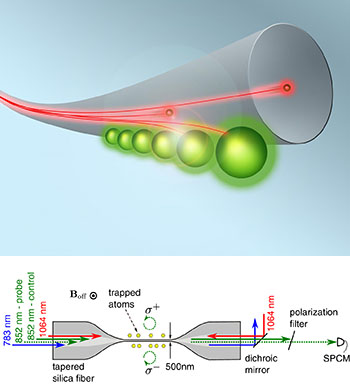
(Top) TU Wien scientists stored information from a light pulse by coupling optical nanofiber to an ensemble of laser-cooled atoms. (Bottom) Sketch of experimental setup. [Images: TU Wien (top); Sayrin et al., Optica, doi: 10.1364/OPTICA.2.000353 (bottom)]
The ability to achieve quantum “optical memory”—trapping, storing and retrieving the quantum state of individual photons on demand—is one key requirement for long-distance quantum optical communication. Scientists from TU Wien, Austria, report that they have succeeded in storing nanofiber-guided optical pulses “at the single-photon level” and retrieving them after several microseconds, by slowing the group velocity of the light pulses in the fiber to a near-standstill (Optica, doi: 10.1364/OPTICA.2.000353). The team believes that the technique offers another potential building block for future quantum information networks.
The quantum storage setup used by the TU Wien researchers begins with an optical fiber that tapers down to a 250-nm-wide waist. The waist area is coupled to an ensemble of laser-cooled cesium atoms, held in place in a 1-D optical lattice created in the evanescent field surrounding the fiber by a combination of two light fields—a 783-nm running-wave light field, and a 1,064-nm standing-wave field—sent through the fiber. The geometry of the setup provides strong coupling between the atoms and the light in the nanofiber waveguide.
The researchers then sent a third set of light pulses, both at 852 nm, down the fiber: a “probe” pulse polarized to be resonant with one quantum transition in the atom ensemble (|1> to |3>), and an orthogonally polarized “control” pulse resonant with a second transition (|2> to |3>). The interaction of the probe pulse and the control pulse with the atom ensemble yields a time delay in the probe pulse, which the team found could be adjusted by tweaking the power of the control pulse. This delay corresponds to a substantial reduction in the probe light’s group velocity (that is, the velocity of the modulation envelope), to as slow as 50 m/s—less than the speed of “any express train,” according to team leader Arno Rauschenbeutel.
Next, to demonstrate storage and retrieval of individual light pulses, the team launched a probe pulse of 0.2 µs duration, and ramped down the control pulse power to zero during the light’s propagation, effectively holding the probe pulse in place and storing the light’s quantum information in the nanofiber-trapped ensemble of atoms. After 1 µs, they retrieved the probe pulse information by ramping the control field back up, and the probe light continued through the optical fiber, its quantum state (and information) undisturbed.
The team notes that the stored pulse contained “0.8 photons on average.” That, in turn, suggests that this approach can be leveraged as a single-photon technique, and should allow the optical memory to “store quantum information and entanglement in an all-fiber-based architecture.”
